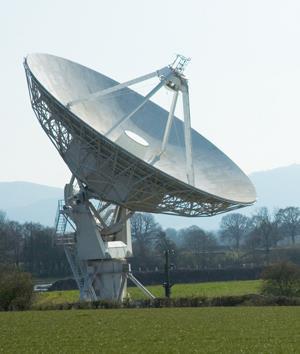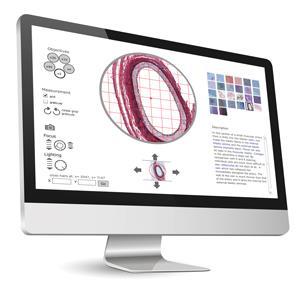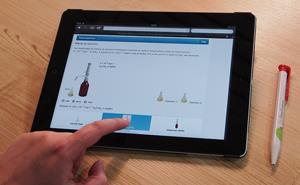Eleanor Crabb discusses the advantages and practicalities of teaching experimental skills online

Practical work is an essential element of any chemistry curriculum that has experimentation at its core. This can be challenging for those offering distance learning, such as the UK’s Open University (OU). Historically, practical skills for distance learners were developed using home experiment kits and occasional intensive face-to-face laboratory sessions. The internet however provides new opportunities for teaching practical science, and access to science learning through new technology is booming.
Some of the skills students learn through practical work require a level of manual dexterity that is best learned in a face-to-face environment, but many others can be achieved using online experiments. Indeed, development of certain practical skills online can provide additional advantages where access to resources, time and facilities is limited.
Two years ago, the OU – with funding from the Wolfson Foundation – launched the Open Science Laboratory (OSL). This globally-accessible online laboratory allows OU students to conduct rigorous investigations using real data and authentic interfaces. In line with the OU’s mission to be ‘open’, a number of the experiments are freely accessible on registration with the site. The OSL also hosts a range of citizen science projects open to everybody.
Types of online practical work
There are many providers of practical science experiments online, from those aiming at school students through to postgraduate level. Medicine was an early adopter with the Howard Hughes Medical Institute, for example, hosting a number of virtual labs for many years. More recently, the Royal Society of Chemistry (RSC) has added a section of screen experiments to their experimentation hub in Learn Chemistry. While many of the virtual chemistry labs found online are simulations, used particularly as pre-lab familiarisation activities, many more involve acquisition and interpretation of data in online experiments.

The sophistication of online experiments varies from a simple video from which students can record data (often with a timer running on screen) to 3D immersive laboratories or field trips based on gaming technology as well as experiments controlled remotely over the internet. For example, the OU has a radio telescope on the Milton Keynes campus and an optical telescope located in Mallorca, Spain, both of which students can access through the OSL. Similarly, the North American Network of Science Labs Online also provides remote access to experiments in physics, biology and chemistry to over 600 students per semester.
Another type of online experiment is the interactive screen experiment that replicates as much as possible a real experimental setup with data provided from archives of results generated by changing experimental variables. Many of these involve an interactive tool that replicates important features of a particular instrument. For example, a digital microscope shell displays digitally captured sections, ranging from rock and meteorite samples to tissue slides, for teaching histology or histopathology.
Citizen science investigations are also well developed in certain areas of science. iSpot, Treezilla, Evolution MegaLab (all available through the OSL) and the Open Air Laboratories programme (OPAL) are good examples. These are online repositories, where individuals post data (often collected using phones and other mobile devices) from observational surveys and fieldwork. The RSC’s Global Experiments are a chemistry related example.
The OSL contains a number of chemistry related experiments including a kinetic investigation of a substitution reaction of a platinum(II) complex, the preparation of kinetic and thermodynamic isomers of a complex and the analysis of pesticides and nitrates in water samples (see box). These experiments require students to make decisions about key aspects of experimental design and planning in order to collect their data.
Supporting students
As in a face-to-face laboratory, students need ample support to succeed. Key to this is a well designed online environment. The experiments themselves need few specific instructions, as they are designed to be embedded in an OU module or some other virtual learning environment with supporting text and video materials covering the background theory. This also enables the same experiment to be used in a slightly different context for different modules and with different levels of support depending on experience. For example, the pesticide analysis investigation has recently been repackaged for delivery to Scottish Higher students to teach gas chromatography–mass spectrometry (GC–MS).
Investigations are supported by an OU tutor, in much the same manner as a demonstrator in a face-to-face session, providing both guidance and reassurance using an online forum or email. Briefing and debriefing events are given using online classrooms. In addition, students support each other via the forums, providing guidance and assistance with data analysis and discussing results within a group.
While in general students using the OSL study independently, collaborative work is possible. In an investigation on drug metabolism and genetic variation, for example, in order to determine the metaboliser status of the entire study population, students work in teams, each investigating a sub-group with a particular genotype; results are pooled and students discuss the data and sources of uncertainty in the forums, wikis and online rooms.
Assessment

Students are assessed on a written report including analysis and interpretation of data. The open ended nature of the experiments and tools that generate random error within datasets ensure that it is virtually impossible for students working independently to have identical data, thus assessment is robust even without using plagiarism-detection software. Students may also be asked to produce an article for a non-scientific audience (such as a press release) or a skills portfolio, mapping and providing evidence for particular skills against the module learning outcomes.
Quizzes are used to check understanding, as well as experimental results themselves. Typically students can have three attempts with personalised feedback dependent on their answer and a reduced score for each attempt. Each question has a number of variants so students can attempt these repeatedly to consolidate their learning.
An important aspect of delivering practical work online is that it can enable the use of analytics to track student activity, as well as monitoring responses to embedded quizzes. Although the use of analytics is in its infancy, ultimately the aim is to identify where students are struggling. In the nitrate experiment for example, of 71 OU students who obtained the correct value for an unknown solution using their calibration curve, 52% obtained the correct answer initially, 31% after one hint and 17% after two hints. Common errors were related to dilution and the use of significant figures, akin to those of their traditional counterparts. Of the students who did not obtain the correct value, 80% answered correctly when they repeated a different variant of the question.
Experiment design
When designing online experiments it is essential that the learning design is driven by the learning objectives rather than the technology. By their very nature, practical skills involve active learning, thus in designing online experiments it is important to build the asset so students have to actively engage with the experiment. They should not be able to just click through a series of buttons to achieve results and should have the opportunity to learn by their mistakes.

Online experiments can be embedded in a module at the precise point of study to support theory in the curriculum, either related to a practical technique or for example a simple calorimetry experiment during theoretical thermodynamics, or a kinetics experiment to support kinetic analysis. To further aid engagement, many of the experiments are delivered through a problem-based learning approach, which embeds other important skills such as digital literacy, communication and time management.
Experiments can also be assembled into larger investigations. In the investigation discussing drug metabolism and genetic variation, students use a succession of online instruments and techniques including a spectrophotometer, high performance liquid chromatography (HPLC) and polymerase chain reaction (PCR) to explore how drug metabolism varies depending on the genotypes of a sample population. In addition, online experiments can provide wider access to rare samples (such as moon rocks) and to virtual labs where access to resources is restricted (such as a virtual animal research facility). Using gaming technologies they can even augment real life, for example by ‘time warping’ during lengthy procedures or in a virtual field trip to overlay landscapes with topographical maps and view rocks at all scales from a field sketch to a microscope slide.
As well as ensuring the experiments are designed to provide true opportunities for conceptual learning, the need to design them to be as accessible as possible should not be ignored. Although experiments can be programmed so they are accessible via a keyboard as well as a mouse, less can currently be done within the program itself to help students with visual impairment, for example. Online experiments require internet access so are not universally available and delivering experiments cross-platform and continued updates to browsers and software can cause technical issues and need for constant maintenance. In addition, although students appreciate the authenticity of remote access experiments, these require a booking system, technical support while the experiment is running and can be labour intensive where chemicals need to be replenished or samples uploaded.
Although it can be argued that online experiments cannot replace face-to-face laboratories, particularly in developing manual dexterity, this is not the intention. As well as familiarising students with particular techniques and apparatus, online experiments offer a real opportunity to deliver practical science at a distance and go a long way to delivering the learning outcomes required of a chemistry graduate.
Eleanor Crabb is a senior lecturer in materials chemistry at the Open University
Measuring levels of nitrates in water samples
Spectrophotometer based assays are used in several OU modules, in both chemistry and biology, for example for quantitation of genomic DNA samples, or to investigate nitrate levels in water. The interactive spectrophotometer provides opportunities to teach the basic principles of instrumentation, including calibration curves, the use of positive and negative controls as well as systematic working practices.
In the nitrates investigation students plan and carry out an online experiment related to nitrate levels in the Florida springs in the US. The experiment is based on a database of real data, both analytical, covering a large timeframe, and observational, on which students prepare and test their own hypothesis. The nitrate concentration is measured using ultraviolet–visible (UV–Vis) spectroscopy after the formation of an azo dye.
In the interactive instrument, students ‘push’ the relevant buttons on the instrument via their mouse, a touchscreen or via accessibility hotkeys to switch on the instrument, to set and change wavelength and to measure the absorbance of the reference and the samples. Importantly the software includes the full absorbance spectrum and does not prevent students collecting data at the ‘wrong’ wavelength. In addition, the programming incorporates a small amount of random error and so the data produced is typical of those obtained with an actual instrument.
To produce a calibration curve, students are provided with a stock solution of known concentration and graduated pipettes. Students do the following:
- choose how many standard solutions to prepare and at what concentrations
- prepare the solutions on-screen using Gilson pipettes and volumetric flasks
- measure the absorbance of their solutions using the spectrophotometer
- produce (and test) their own calibration curve.

Should students prepare the standards incorrectly or choose a concentration beyond the working range of the instrument this will be reflected in the data they obtain. Indeed, a number of students return to prepare additional standards to improve their curve. Students then analyse a number of water samples, the choice of which depends on their own hypothesis based on information related to a selection of springs, They reflect on how the experimental data ‘fits’ their hypothesis, as well as the reliability of measurements and sources of variability in their report.
This type of open experiment provides greater freedom and opportunities for learning than a more recipe driven approach that can be prevalent in more time restricted lab sessions.









1 Reader's comment